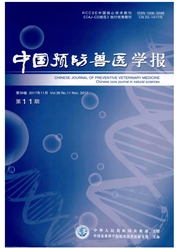

 中文摘要:
中文摘要:
为确定2014年河北某猪场哺乳仔猪群腹泻的病原,本研究从该发病猪场采集了22份临床样品,采用PCR方法进行腹泻病原的检测。结果显示其中17份样品为猪流行性腹泻病毒(PEDV)阳性,而猪传染性胃肠炎病毒(TGEV)和猪轮状病毒(PoRV)均为阴性。选取其中5份PEDV阳性样品在Vero细胞中进行病毒的分离,结果显示,仅一份样品在接种细胞24 h后即可观察到细胞病变。对病变细胞进行RT-PCR及间接免疫荧光鉴定均为PEDV阳性。将分离的病毒株命名为He B10/2014。将其在Vero细胞中传至F5代次后病毒增殖明显增快,病毒滴度于感染细胞24 h达到峰值。对分离株的S基因进行克隆和测序分析,结果显示该病毒分离株符合国内近年来流行病毒株S蛋白的变异特征,即在S蛋白中存在4个连续氨基酸的插入(^(59)QGVN^(62))和3个氨基酸的缺失(^(14)0N和^(163)NI^(164))。本研究结果表明分离获得的HeB10/2014株为国内近年来新的PEDV流行株。
 英文摘要:
英文摘要:
To examine the cause of a severe diarrhea outbreak mainly to the neonates on a pig farm in Hebei in 2014,twenty-two feces samples were collected from the sick piglets and detected by RT-PCR assay. While seventeen samples were positive for porcine epidemic diarrhea virus(PEDV). Then the PEDV was isolated with Vero cells which produced palpable cytopathic effect(CPE) at 24 hrs post inoculation, and the isolate was further confirmed to be PEDV by both RT-PCR and indirect immunofluorescent assay with PEDV positive serum, named He B10/2014. Moreover, the complete S gene of the isolate was sequenced and 7 mutants were found in the deduced amino acid sequence of S protein, including 4(~(59)QGVN~(62)) insertions and 3 deletions(^140N 和 ^163NI^164) which showed the mutations were identity to the new mutated and concurrently prevalent PEDVs in China for recent years.
 同期刊论文项目
同期刊论文项目
 同项目期刊论文
同项目期刊论文
 期刊信息
期刊信息
